Flexible Office Design: Creating Spaces That Work for Everyone
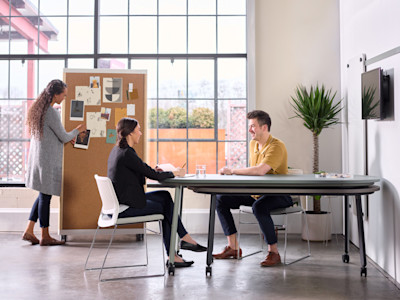
With the increasing adoption of the hybrid model, companies are left trying to figure out how to transition to an office that better meets employee needs. Companies are having to focus on what’s important – functionality and experiences. Following the pandemic and employees experiencing a taste of independence and freedom, employees have developed a work style that is hard to translate into office design.
Modern office design has shifted to addressing the unique needs of the workforce. Whether it’s a focus on connection or the increasing need for wellness areas, companies are starting to build nontraditional spaces. These spaces might be difficult to incorporate into the traditional office. However, flexible office designs can make it easier to include these much-needed zones. But why do you need a flexible office design?
A flexible office design can help you seamlessly integrate these specialized solutions into an office space. Creating division in the office can have a negative impact on the way we work. However, a flexible office design can help you avoid this division and lead to a more efficient and effective office design. But what is a flexible office design?
What is a Flexible Office Design?
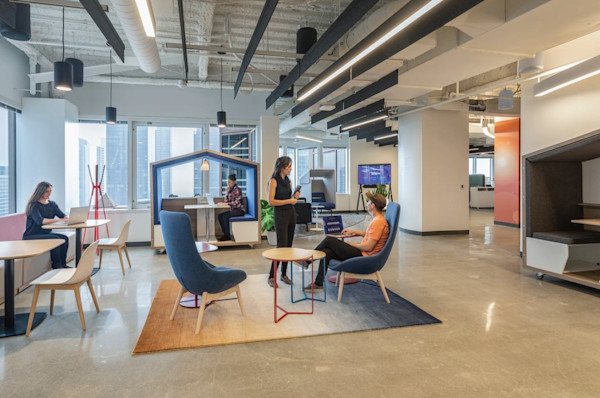
>>Discover what furniture is right for your flexible office space<<
A flexible space is dynamic. Rather than a single designated section for work or conference rooms for collaboration, a flexible office design provides employees with multiple settings or zones to work in. In short, a flexible office space gives employees a change of scenery. Multiuse furniture and specialized zones are designed for people and their needs. Flexible office spaces meet employee needs without confining them to a single cubicle or space.
A flexible design is unique to the employees and the company. It is completely intentional in design. The spaces created for employees are designed to help them work more efficiently and effectively. In all aspects of their job duties. A flexible office lets employees work in a space specific to the task they’re working on at the moment.
If a certain project is better suited for an informal relaxed space, there’s an area for that. If an employee needs a private area, there are workstations designed to reduce distractions. The flexible office design gives employees the resources they need to work as efficiently as possible while making the workplace a more enjoyable experience.
What Does a Flexible Office Look Like?
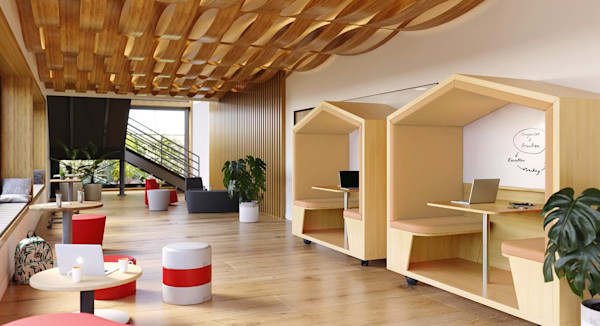
>>Learn more about designing your flexible office space<<
The flexible office looks different to everyone. However, the concept is the same. Although some companies have designed the model flexible office that has become the poster child for office design, it might not fit your employees the same. The flexible office should meet your specific needs, represent your employees, and overall make the average work day easier and more enjoyable.
Industry-leading and innovative companies are breaking the mold of office design. And many of them create flexible offices as the basis for change. Intuit has recently opened a unique concept in a 360,000-square-foot office space. Intuit has pulled inspiration from cities. The use of “neighborhoods” establishes zones for different workstyles and different roles. Not only are the zones designed to meet both specific and evolving needs, they also carry varying aesthetics throughout.
The “city” concept is an idea that meets employee needs, whatever they may be. Is your flexible office design going to look the same as this sprawling campus? Probably not. But should it strive for the same outcome? Yes. The extent of intricacy and specificity depends on what you need. Your office should reflect you, what you need, and how you work. But does a flexible office space make a difference in how we work? It might have a bigger impact than you think.
Do Flexible Offices Help Employees?
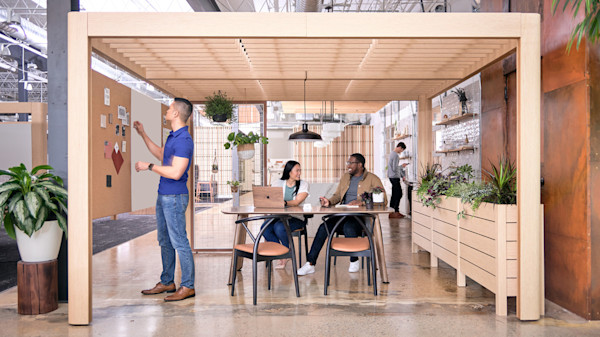
>>Find out more about designing custom work zones for employees<<
A flexible office has a huge impact on how your employees work. From connectivity to functionality, what employees get out of a flexible office can improve efficiency and effectiveness. To what degree a flexible office can help your employees depends on what tools you give them. Let’s look at some of the most common zones in flexible office design and the impact they have on employees.
Focused Areas
Regardless of the scope of work or industry, employees need intentional spaces for focused work. Focused areas give employees a space free from distractions. These spaces are typically positioned away from high-traffic areas to avoid interruptions. For added seclusion, acoustic phone booths, furniture, and acoustic panels are used to dampen sound.
These solutions are ideal for smaller offices which make it more difficult to separate these zones. Employees are still able to work in private areas with a secluded feel without alienating them from the rest of the office. A LinkedIn article discusses how focused areas improve productivity. Private and focused spaces give employees a space free from distractions and control over their environment. This can lead to improved focus and concentration.
Breakout Zones
Employees need to connect. They also need an area where they can escape the rigidity and structure of their workspaces. The breakout zone is the ideal solution. These spaces have evolved from the traditional “water cooler.” The breakout zone provides employees with an informal space to connect, break, and build workplace bonds that can help overall mood and morale. Occasional tables, modular lounge seating, and comfortable design give employees the perfect place to gather. Breakout zones usually have an informal design.
Collaboration Areas
Collaboration is necessary for most companies. Whether it’s a traditional boardroom with modern conference tables or a more innovative creative space, the meeting of minds can lead to great ideas. There’s no one way to design a collaboration zone. Informal collaboration spaces are more likely to use relaxed comfortable seating. While formal meeting areas might have a more rigid design. Collaboration zones are likely important to the success of your business and the way you design them is just as important.
What Furniture Do You Need to Create a Flexible Office?
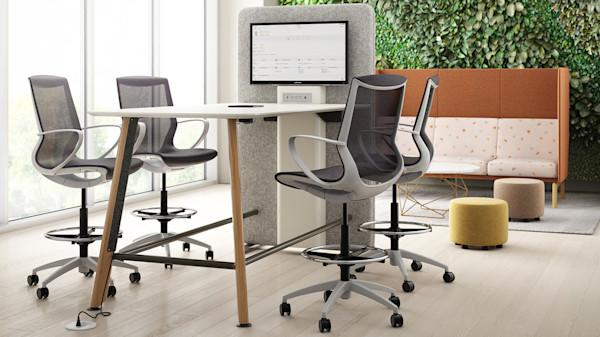
>>Design the ideal flexible office with our product collections<<
A flexible office is the perfect marriage of functionality and fluidity. Because the flexible office design is intended to meet many needs, the furniture you use in your design is key to success. Even though flexible spaces and zones start with design, it’s important to use furniture that meets employee needs. Here are a few of the most important pieces to use in flexible office zones:
Movable and Mobile Furniture
Nothing screams functionality the way movable furniture does. These pieces give employees the ability to transform or adjust spaces to specific needs. Movable furniture can be as simple as modular lounge seating or something as mobile workstations that fold out of sight when not in use. Movable and mobile furniture pieces offer an optimal solution for maximizing the functionality of designated work zones.
Modern Standing Desks
A flexible office design is focused on employee needs and well-being. The active work lifestyle has become more popular for employees and the furniture reflects this. Some companies that have the ability and space have dedicated wellness areas with everything from gyms to spas. However, for the office that doesn’t have the space or the workforce to support an entire space dedicated to wellness, our adjustable height desks can easily satisfy those needs. They're also an important feature of our modular workstations.
These workstations are a great reprieve from hours of seated work. They also offer a wealth of health benefits. Harvard Health discusses the benefit of standing desks. Sitting long hours can lead to obesity, diabetes, and cardiovascular disease. Standing desks don't only give employees different options, but they can also protect your greatest assets.
The Modern Office Cubicle
The cubicle has evolved into a functional workspace and a statement piece. Although a flexible office includes unique zones, the traditional workspace shouldn’t be neglected. Our curved modern cubicles have a modular space-saving design. The StrongProject modern cubicle gives employees the ideal focused workstation with adaptability to adjust desk height, easily rearrange, and customizable partitions to meet employee needs. Our modern cubicles also have a striking aesthetic that will bring the traditional office into the future of work.
Easy Ways to Implement a Flexible Office
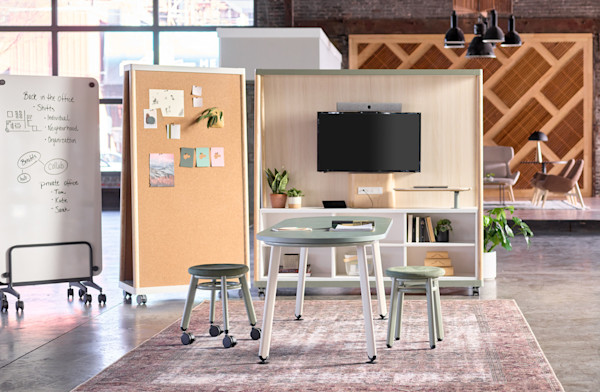
>>Find solutions to create flexible zones today<<
Redesigning an office can be a major undertaking, but our design team is here to help. However, you don’t need to completely start from the ground up. Building a flexible office space can be easy and the results can be immediate. Changing the layout and organizing the flow of work is a great place to start. Using key pieces will also help you transform your office.
Flexible zones are created with movable partitions to create unique spaces. Modular seating can help your employees use one designated space as a meeting area or a breakout area. If you don’t have much space, acoustic phone booths are an easy way to add privacy. Especially in a congested area. Building a flexible office space shouldn’t be hard. The design should be seamless and functional. Listening to your employees’ needs will help you discover what they need the most.
Are you thinking about transitioning to a flexible office design? Contact us to find out how this change can help your employees work.
Check out these other topics on helping employees through office design:



